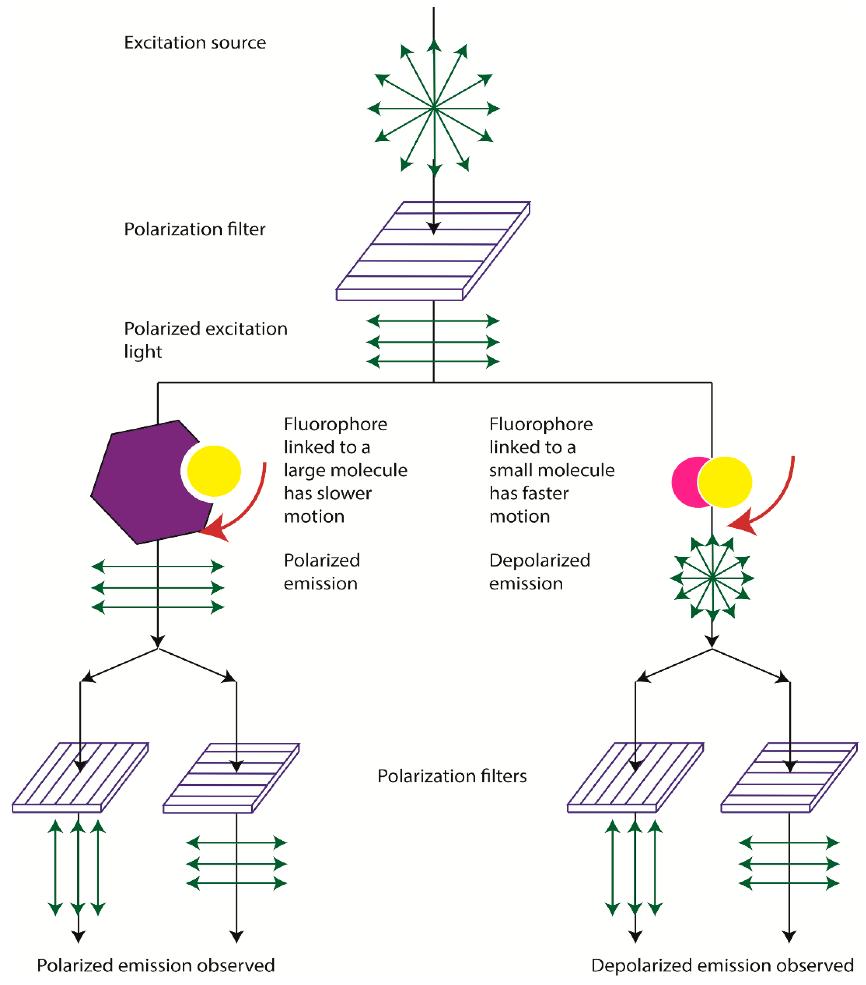Fluorescence Polarization Anisotropy (FPA)
Online Inquiry
Fluorescence polarization anisotropy (FPA) is a widely used technique in antibody drug characterization. Creative Proteomics offers FAP-based characterization service to assess binding interactions between antibodies and target antigens. The insights gained from FPA can aid in the development of antibody drugs and their potential therapeutic applications.
Introduction of Fluorescence Polarization Anisotropy
The analytical use of FPA is based on irradiating a reaction mixture containing fluorophore-labeled molecules with plane-polarized light and recording the fluorescence that this irradiation induces. In a solution of disordered molecules, polarized light will preferably be absorbed by those whose absorption oscillators are parallel to the plane of polarization. If the excited molecule does not change its orientation in space before emission, the fluorescence emission will also be polarized. Measurements of anisotropy can be utilized to create binding curves while adjusting the ligand concentration in relation to its receptor. This method enables the computation of affinity constants from corresponding binding curves.
 Fig. 1 Principle of fluorescence measurement under irradiation with plane-polarized light. (Hendrickson, O. D. et al., 2020)
Fig. 1 Principle of fluorescence measurement under irradiation with plane-polarized light. (Hendrickson, O. D. et al., 2020)
Application of FAP in Characterization of Antibody Drugs
Fluorescence polarization anisotropy (FPA) is a robust analytical technique that we use extensively for characterizing antibody drugs. It provides customers with valuable information regarding the activity, stability, and drug-drug interactions of such drugs.
- Determining binding affinity
When a fluorescently labeled antibody binds to an antigen, it changes the rotational motion of the antibody which results in a change in fluorescence polarization. FPA determines the binding constant through the interaction of a relatively small fluorescence-emitting ligand with a larger receptor molecule.
- Determining dissociation constants
By monitoring changes in fluorescence polarization over time, we can determine the rate of formation and dissociation of antibody-antigen complexes, enabling us to characterize the antibody drug according to its binding affinity and thermodynamics.
- Chemometrics related information
By measuring the fluorescence polarization of antibodies and antigens at varying concentrations, we can ascertain the quantity of binding sites on the antigen and the ratio of the complexes.
- Detecting conformational changes
FPA can be utilized to examine conformational changes of an antibody medication attached to its target by detecting modifications in fluorescence polarization connected with antibody-target interaction.
Advantages of Our Fluorescence Polarization Anisotropy (FPA) Technology
- High sensitivity. Even small changes in rotational mobility can be detected, which makes it highly responsive to molecular interactions.
- Label-free analysis simplifies and accelerates sample preparation while minimizing the risk of introducing artifacts or interfering with protein function.
- FPA measurements can be performed rapidly, enabling high-throughput screening and analysis for large-scale antibody drug discovery.
- The small amount of sample required makes it suitable for early antibody drug development studies with limited samples.
- Suitable for all aspects of antibody drug characterization, including epitope mapping, protein-protein interactions, stability analysis and aggregation studies.
Creative Proteomics' experts are well versed in FPA and can provide comprehensive services for antibody drug characterization. We utilize state-of-the-art equipment and robust methods to deliver accurate and reliable results. No matter what stage of antibody drug development you are in, our FPA technology can meet your specific needs. Contact us to learn more about our service and we will be happy to serve you.
Reference
- Hendrickson, O. D.; et al. Fluorescence polarization-based bioassays: new horizons. Sensors. 2020, 20(24): 7132.

 Fig. 1 Principle of fluorescence measurement under irradiation with plane-polarized light. (Hendrickson, O. D. et al., 2020)
Fig. 1 Principle of fluorescence measurement under irradiation with plane-polarized light. (Hendrickson, O. D. et al., 2020)